US Fish and Wildlife Service Reverses its Position on Take Permit for Yuma Clapper Rail
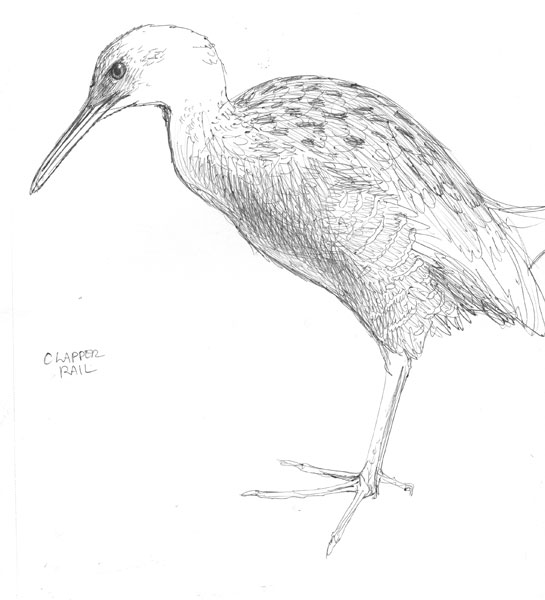
^Field sketch of Clapper rail, Laura Cunningham. Ballpoint pen on paper.
April 15, 2018 - Amargosa Valley NV - Without scientific evidence, the US Fish and Wildlife Service (FWS) has reversed their position that big solar projects pose a risk to endangered birds such as the Yuma Ridgeway Rail (Rallus obsoletus yumanensis). They claim the risk is now "unquantifiably low" even though two have turned up dead on solar projects. Since the large build out of large-scale solar projects in the western US, thousands of dead birds have turned up under the panels and heliostats. It is believed that large solar projects mimic lakes and that attracts birds and can result in collision or other mortality. FWS had worked out a Habitat Conservation Plan/Take permit for the project with the developer, First Solar, and it was cancelled overnight in February.
This is a bad precedent for Habitat Conservation Plans everywhere, and for declining species such as the Yuma clapper rail.
See the Mojave Desert Blog excellent analysis of this.
Company Seeking Incidental Take Permit for Yuma Clapper Rail
November 17, 2016 - Amargosa Valley NV - The Sunshine Valley Solar Project would be built next to Ash Meadows National Wildlife Refuge, Nevada which attracts over 300 species of migrating birds. The US Fish and Wildlife Service just informed us that First Solar is seeking an Incidental Take Permit (permission to harm, kill, harass, etc.) for the Federally Endangered Yuma clapper rail because they are admitting that the project would be bad for birds attracted to a "lake effect" produced by the project. While this article is a basic commercial for the project, the environmental impacts and the recent news about First Solar restructuring and downsizing production are not mentioned. If First Solar is granted a Take permit, they would develop a Habitat Conservation Plan designed to compensate for expected bird mortality caused by the project.
For more background on the "lake effect" and solar project threats to birds, see this 2014 article in Scientific American.
More news about this project at Pahrump Valley Times.
Sunshine Valley Solar Project Gets Utility Agreement
January 19, 2016 - Amargosa Valley NV - A Power Purchase Agreement has been signed for the Sunshine Valley Solar Project, a 100 MW solar project on 800 acres of private land located 8 miles from Ash Meadows National Wildlife Refuge in Amargosa Valley, Nevada. The US Fish and Wildlife Service has determined that this project will kill Endangered Yuma clapper rails (and other birds). The project will be built in Nevada by First Solar and the power sold to Southern California Edison in California.
For birds, we talked to US Fish and Wildlife; they recommended that First Solar apply for a Take permit for Yuma Clapper Rail. FWS can only suggest this, not require it, and they can get the county and Nevada Division of Wildlife to require monitoring in a Habitat Conservation Plan. FWS will also issue a biological opinion, but First Solar has not responded.
The reporting of bird mortality has not often been rigorously collected, especially on private land projects, but waterbirds such as ducks and rails landing on the solar panels because they look like a lake out in a valley has been reported osccasionally. We are concerned this type of data is under-reported to agencies.
There are gigantic solar projects now in El Dorado Valley in the Boulder City, Nevada Green Zone. It is all land owned by Boulder City. The biological resources are all monitored under the Clark County Habitat Conservation Plan. There is no requirement to report bird kills on about 6,000 acres of solar projects.
First Solar, California Utility Sign Agreements for 500MW
First Solar, Inc. (NASDAQ: FSLR) and Southern California Edison (SCE) have announced the signing of Power Purchase Agreements (PPAs) for the off-take of electricity generated by four solar projects totaling 500 megawatts (MW)AC of capacity. The deals establish SCE as the largest single off-taker of energy from First Solar projects in the world. The PPAs are for power generated by four projects in California, Nevada and Arizona, all currently in development by First Solar, with anticipated commissioning by the end of 2019:
* The 150MWAC North Rosamond Solar Project, located in Rosamond, Calif., will occupy approximately 1,175 acres of private land, and will produce approximately 488,000 MWh/year.
* 100MWAC from the Willow Springs Solar Project, located near the North Rosamond Solar Project in Rosamond, Calif., which will occupy approximately 1,450 acres of private land, and will produce approximately 330,000 MHh/year.
* The 100MWAC Sunshine Valley Solar Project will be located in Amargosa, Nev., less than four miles from the California border, on privately owned land. It will produce approximately 302,000 MWh/year.
* The 150MWAC Sun Streams Solar Project will be located on approximately 1,500 acres of land in Tonopah, Ariz., and will produce approximately 464,000 MWh/year.
Basin & Range Watch Sends Advising Letter to Sunshine Valley Solar
October 14, 2014 - Amargosa Valley NV - Basin & Range Watch retained an attorney to write a letter of advice to Sunshine Valley Solar LLC over the potential for Federally Endangered Yuma clapper rail "take" (mortality) on the proposed Sunshine Valley Solar Project in Amargosa Valley near the wetlands of Ash Meadows National Wildlife Refuge in Nye County NV. We believe it would be both prudent and legally appropriate for Sunshine Valley Solar to initiate the application process for an Incidental Take Permit.
The Yuma clapper rail (Rallus longirostris yumanensis) is a marsh bird listed as endangered under the Endangered Species Act. According to a July 2014 letter from the US Fish and Wildlife Service to Sunshine Valley Solar providing the agency’s comments on the Project, solar photovoltaic (“PV”) facilities like the Sunshine Valley Solar Project “present a new source of mortality for Yuma clapper rails” because “[t]hese facilities reflect light during the day and night, producing a lake or pond effect that may attract rail species and other water-associated birds.” Several rail bird mortalities caused by this “lake effect” at PV facilities have been documented, and the actual number of mortalities is likely higher than this documentation reflects, as scavengers often remove bird carcasses before they can be accounted for. See the letter >>here.
US Fish & Wildlife Service Says Yuma Clapper Rail Kill Likely for Solar Project
August 1, 2014 - Amargosa Valley NV - The US Fish and Wildlife Service (FWS) sent a letter dated July 11, 2014 to the Nevada Public Utilities Commission concerning the likely killing of a rare Yuma clapper rail which is federally endangered, at the 110 MW Sunshine Valley Solar Project on private land in Amargosa Valley. The proposed project would be 8 miles northwest of Ash Meadows National Wildlife Refuge where occupied marsh habitat exists. FWS said it beleives an incidental take of Yuma clapper rail is likely. At least one Yuma clapper rail has been found killed at the Desert Sunlight Solar Farm in Riverside County. FWS recommended that the parent company First Solar develop a Habitat Conservation Plan to support an application for an incidental take permit for Yuma clapper rail. Additionally the Service wants the developer to have a Bird and Bat Conservation Strategy to avoid, minimize, and mitigate deaths of birds under the Migratory Bird Treaty Act.
Amargosa Valley New Large Solar Proposal
June 3, 2014 - Amargosa Valley, Nevada - Basin & Range Watch visited a proposed photovoltaic power plant on private land in the Amargosa Valley of Nevada, near the prized Ash Meadows National Wildlife Refuge where springs and lakes attract thousands of sandpipers, shorebirds, ducks, geese, and other birds to an oasis in the desert.
The Sunshine Valley Solar Project is a First Solar photovoltaic project that would be built on 785 acres of private land in the Amargosa Valley. It would require new substations and overhead transmission as well. First Solar has submitted an application and “Environmental Statement” to the Nevada Public Utilities Commission. In the document, First Solar acknowledges that they conducted desert tortoise and burrowing owl surveys, but makes no mention of the polarized glare effect that is killing birds and insects on other solar projects. It is also our understanding that the US Fish and Wildlife Service has contacted First Solar about these concerns, but the document makes no mention of that either. The document can be seen here: http://pucweb1.state.nv.us/PDF/AxImages/DOCKETS_2010_THRU_PRESENT/2014-5/38370.pdf
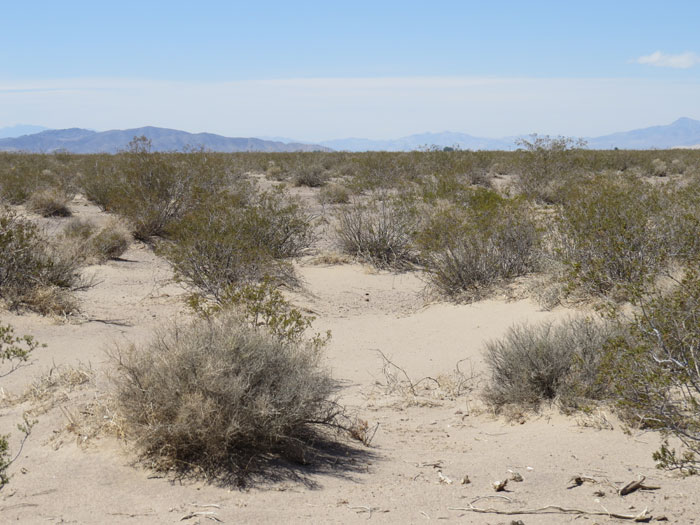
^A sandy creosote flat with desert iguanas and whiptail snakes, potentially to be bulldozed of First Solar builds a photovoltaic power plant here. The area was said to be "disturbed" and old agricultural land but it appears to be old growth Mojave Desert Scrub. Farms lie to the west mostly.
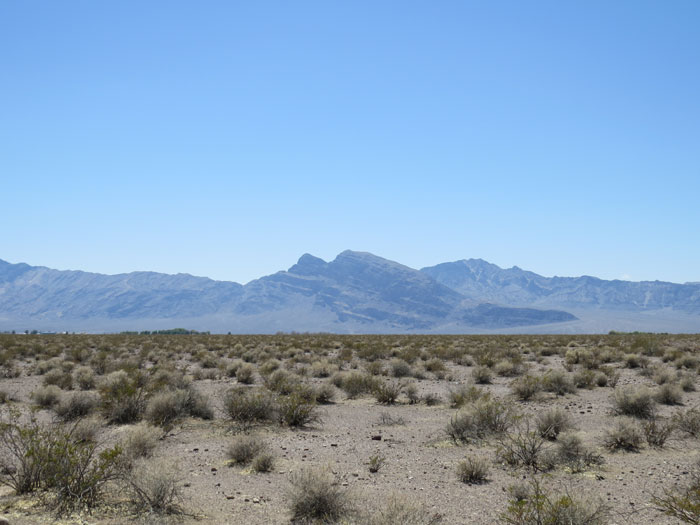
^Another part of the project proposal, the Funeral Mountains in Death Valley National Park lie in the distance.
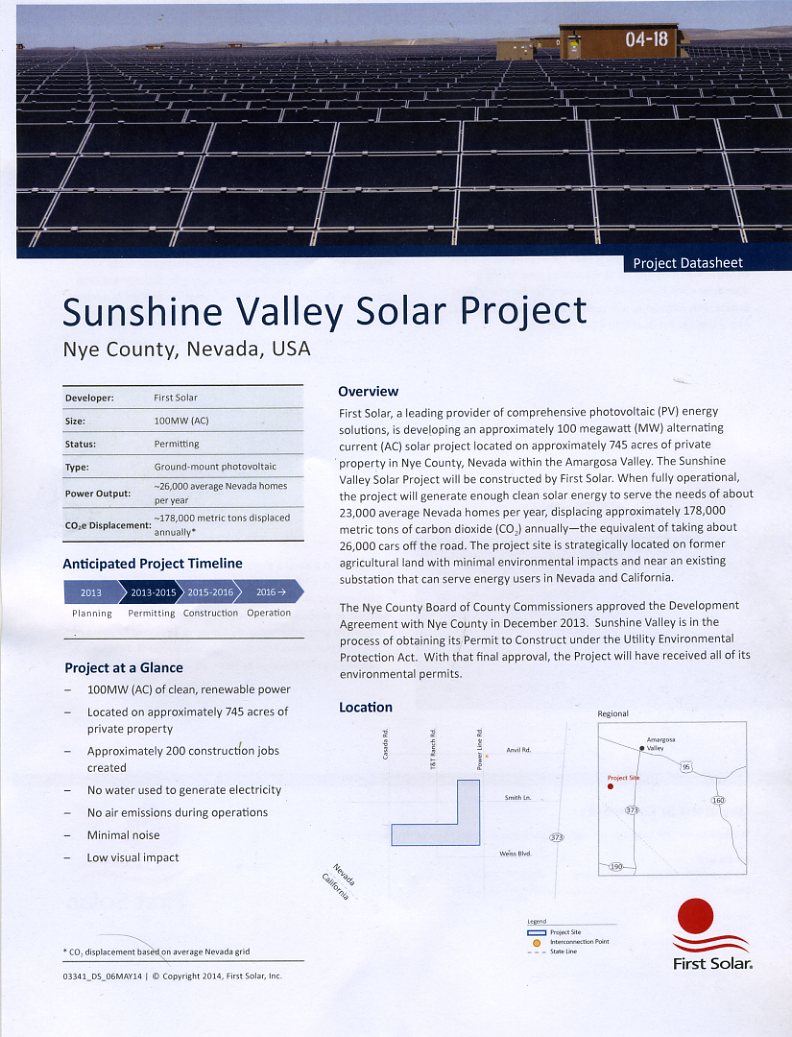

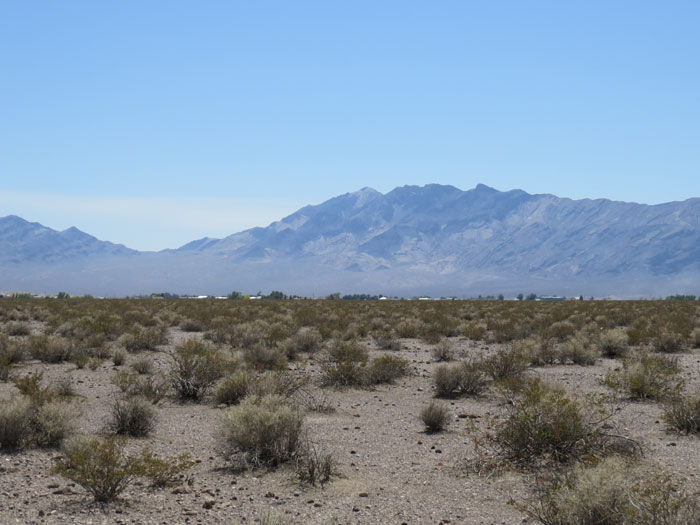
^Looking west towards the Funeral Mountains.
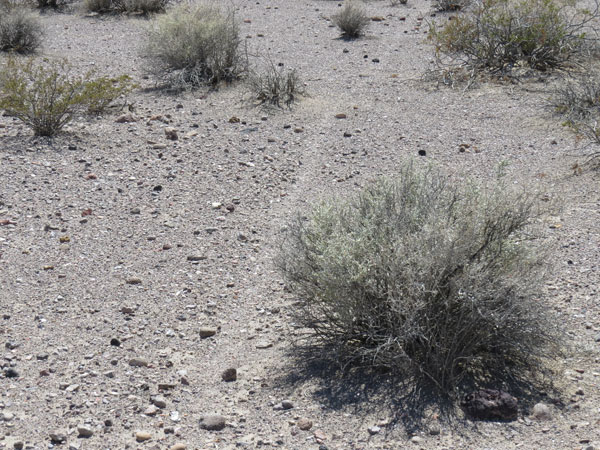
^A kit fox trail.
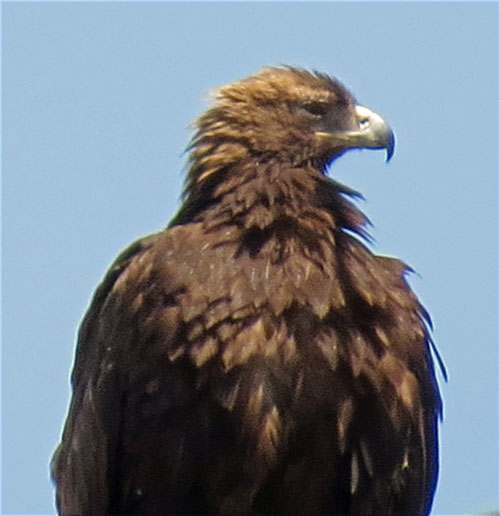
^Golden eagle perched on a wooden telephone pole along Amargosa Farm Road a few miles north of the project site seen May 2014. The Amargosa Valley is a stronghold for golden eagles and the project will remove 785 acres of foraging habitat for the species and will build new transmission which could be potentially dangerous.
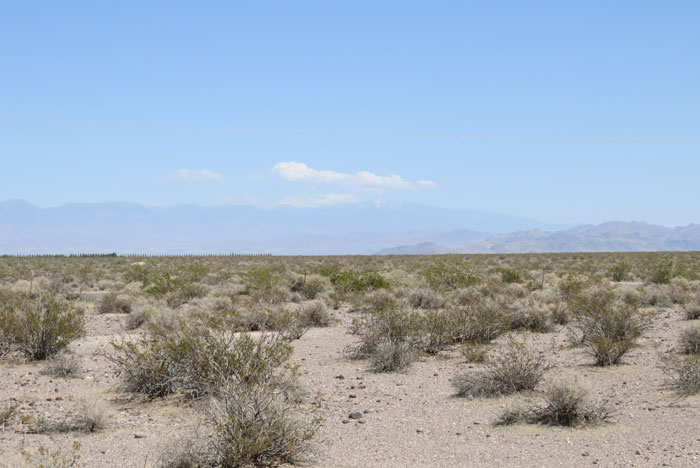
^Looking eastward to Mt. Charleston and the Spring Range, from the project site.
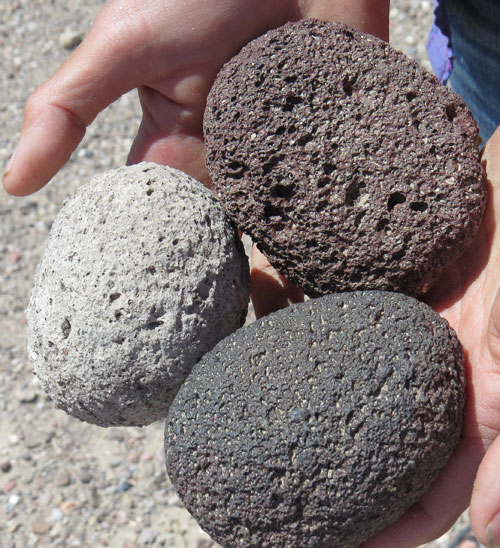
^Different colors of rounded basalt spewed out of a cinder cone to the north. Cobbles and pebbles are rounded and may represent an old meander in the Amargosa River which flows to the west.
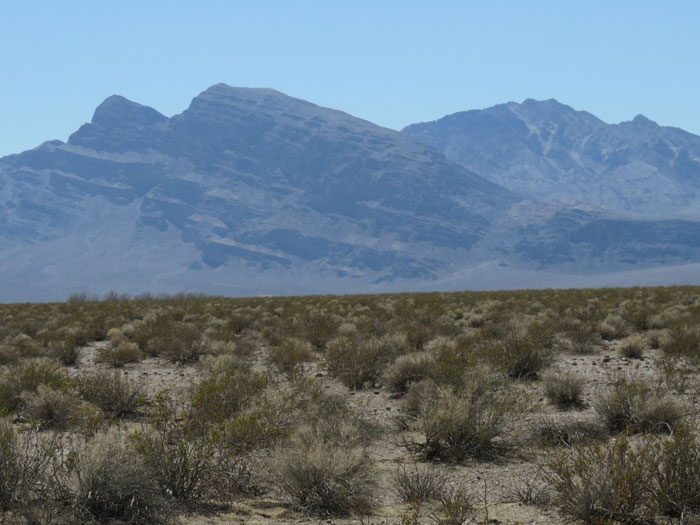
^Funeral Mountains wilderness in Death Valley National Park, to the west of the project.
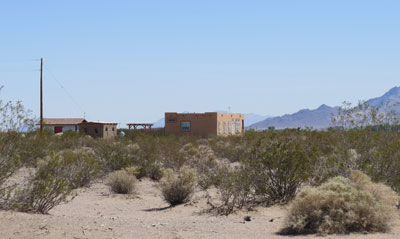
^Residences next to the project proposal. Right now the character of the area is quiet, rural, and with large areas of open space.
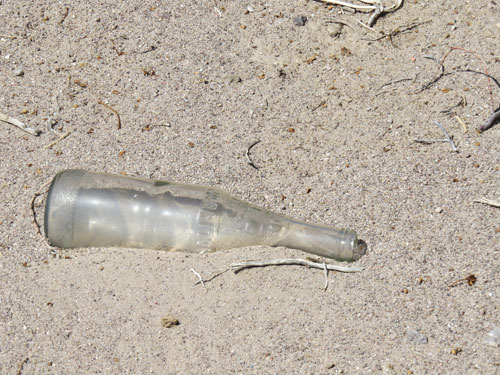
^An old glass bottle along the dirt road bordering the project, partly sandblasted by winds.
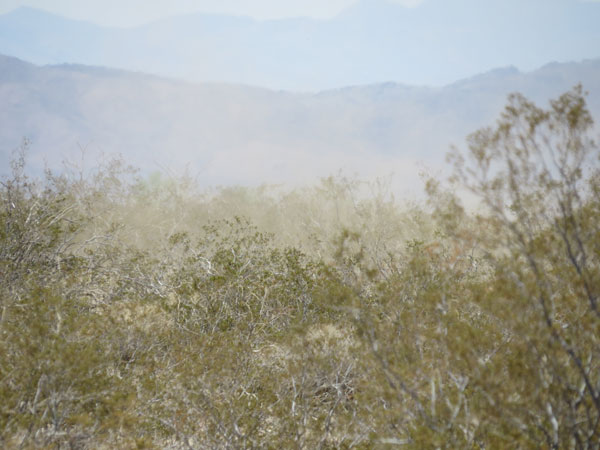
^A dust whirlwind sweeps through the creosote.
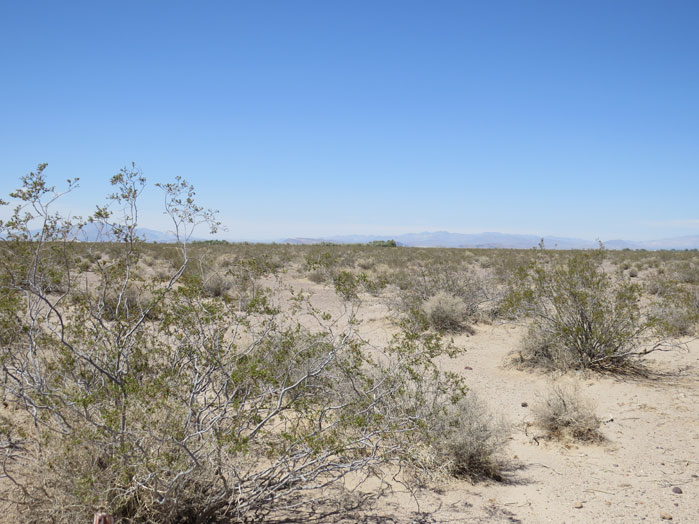
^If the winter has been rainy this Mojave Desert flat is often covered in spring with wildflowers. This year was dry.
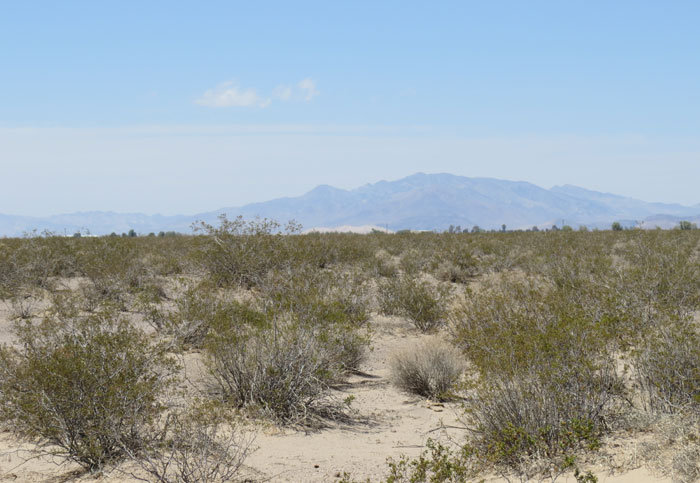
^Big Dune, looking northward.
Bird Issues and Solar Projects
This is a letter Basin & Range Watch sent to the Nevada Department of Wildlife and Nevada Public Utilities Commission.
Large solar projects are creating a polarized glare or lake effect and are causing birds and insects to be deceived and collide with solar panels or simply dehydrate. The avian impacts are not fully understood, but everyone seems to agree that this problem was underestimated during the initial boom to fast track big solar on both public and private lands in the Southwestern US. The polarized “lake effect” is now well known from the Genesis, Desert Sunlight and Ivanpah Projects, all in California. Bird species that have collided with solar panels and heliostats and if not killed outright have dehydrated. These include the federally Endangered Yuma clapper rail, peregrine falcon, American kestrel and a host of water birds. Very few focused surveys are occurring in the state of Nevada. The Crescent Dunes solar power tower will have these surveys take place after the project goes on line this winter.
At this point, those California projects are among the few that are reporting findings of dead birds at their sites.
The Sunshine Valley Solar Project would replace 785 acres of desert habitat with thousands of lake like solar panels. The project will be built approximately 5 miles from Ash Meadows National Wildlife Refuge. Over 300 species of birds have been documented at Ash Meadows. Spring migration usually occurs during April and May, and fall migration from mid-August through September. Water birds are abundant on the marshes in the winter. The area represents an important flyway for birds between the Soda Springs complex, Grimshaw Lake, Saratoga Springs, Amargosa Canyon, and the Oasis Valley, Nevada. Ash Meadows is part of the Pacific Flyway for birds and is linked to Walker Lake, Mono Lake, the Sierra Nevada, Owens Valley, the Spring Mountains, the Colorado River and the Salton Sea. The list of birds for Ash Meadows includes the Federally Endangered Yuma clapper rail and the rare yellow billed cuckoo. It is very possible that this project will kill an Endangered Species.
In 2008, there was a very strong localized rain storm that filled up Silver Lake, located in the Silurian Valley, California for about two months. See the photo of the temporary lake below. We also saw white pelicans on the lake but do not have a photo of the birds.
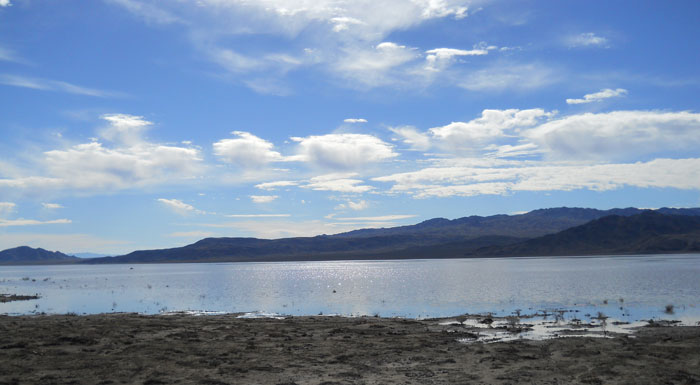
^Silver Lake just north of Baker, California and adjacent to the project site after strong rains in 2008.
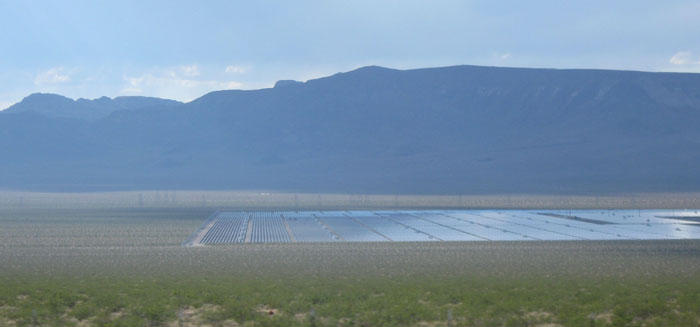
^Lake effect from the Copper Mountain Solar facility south of Boulder City, Nevada.
If a real, ephemeral lake can attract white pelicans to the Silurian Valley, than there should be concern that an artificial lake would attract birds to areas adjacent to Ash Meadows.
Recently, the US Fish and Wildlife Service released a report called “Avian Mortality at Solar Energy Facilities in Southern California: A Preliminary Analysis” Rebecca A. Kagan, Tabitha C. Viner, Pepper W. Trail, and Edgard O. Espinoza National Fish and Wildlife Forensics Laboratory
The report has enough information to tell us that incidental reporting of bird mortality from solar projects does not really give the complete numbers. The report finds that “Trauma was the leading cause of death documented for remains at the Desert Sunlight (First Solar project) and Genesis sites."
The report also states, “These solar facilities appear to represent 'equal-opportunity' hazards for the bird species that encounter them. The remains of 71 species were identified, representing a broad range of ecological types. In body size, these ranged from hummingbirds to pelicans; in ecological type from strictly aerial feeders (swallows) to strictly aquatic feeders (grebes) to ground feeders (roadrunners) to raptors (hawks and owls). The species identified were equally divided among resident and non-resident species, and nocturnal as well as diurnal species were represented.”
The two main identified cause of mortality from photovoltaic projects are trauma and predation.
The report details the mortality at the 4,500 acre Desert Sunlight photovoltaic site which was built by First Solar:
“Sixty-one birds from 33 separate species were represented from Desert Sunlight. Due to desiccation and scavenging, a definitive cause of death could not be established for 22 of the 61 birds.
"Blunt force impact trauma was determined to have been the cause of death for 19 Desert Sunlight birds including two Western Grebes (Aechmophorus occidentalis) and one each of 16 other species. Impact (blunt force) trauma is diagnosed by the presence of fractures and internal and/or external contusions. In particular, bruising around the legs, wings and chest are consistent with crash-landings while fractures of the head and/or neck are consistent with high-velocity, frontal impact (such as may result from impacting a mirror).
"Predation was the immediate cause of death for 15 birds. Lesions supporting the finding of predation included decapitation or missing parts of the body with associated hemorrhage (9/15), and lacerations of the skin and pectoral muscles. Eight of the predated birds from Desert Sunlight were grebes, which are unable to easily take off from land. This suggests a link between predation and stranding and/or impact resulting from confusion of the solar panels with water.
"Challenges to data collection included rapid degradation of carcass quality hindering cause of death and species determination; large facilities which are difficult to efficiently search for carcasses; vegetation and panels obscuring ground visibility; carcass loss due to scavenging; and inconsistent documentation of carcass history. Searcher efficiency has been shown to have varying influences on carcass recovery with anywhere from 30% to 90% detection of small birds achieved in studies done at wind plants (Erickson et al., 2005). Scavengers may also remove substantial numbers of carcasses. In studies done on agricultural fields, up to 90% of small bird carcasses were lost within 24 hours (Balcomb, 1986; Wobeser and Wobeser, 1992). OLE staff observed apparently resident ravens at the Ivanpah power tower. Ravens are efficient scavengers, and could remove large numbers of small bird carcasses from the tower vicinity. (Erickson, W. P., G. D. Johnson, and D. P. Young, Jr., 2005, A summary and comparison of bird mortality from anthropogenic causes with an emphasis on collisions: U S Forest Service General Technical Report PSW, v. 191, p. 1029-1042; Balcomb, R., 1986, Songbird carcasses disappear rapidly from agricultural fields: Auk, v. 103, p. 817-820; Wobeser, G., and A. G. Wobeser, 1992, Carcass disappearance and estimation of mortality in a simulated die-off of small birds: Journal of Wildlife Diseases, v. 28, p. 548-554.).“
The report concludes:
“Given these variables it is difficult to know the true scope of avian mortality at these facilities. The numbers of dead birds are likely underrepresented, perhaps vastly so. Observational and statistical studies to account for carcass loss may help us to gain a better sense of how many birds are being killed.”
And the photovoltaic projects have insect impacts: “Light and noise pollution associated with electrical power plants can be problematic for wildlife. Polarized light pollution from PV panels can attract aquatic insects and other species that mistake the panels for bodies of water, potentially leading to population decline or even local extinction of some organisms (Horvath et al. 2010). Nighttime lighting for security or other reasons may negatively impact a variety of Mojave Desert species, many of which have developed nocturnal behavior to escape the daytime heat of the desert. (Mojave Desert Ecoregional Assessment September 2010, The Nature Conservancy of California 201 Mission Street, 4th Floor San Francisco, CA 94105) p. 50.”
The only real organized surveys for avian mortality are taking place at the Ivanpah Solar Project with only a 20 percent coverage. They have now discovered 3 kit fox dens in the project site as well as active raven nests. It is likely that scavengers are removing birds before they can be counted. The rest of the finds are simply incidental which may indicate that mortality numbers are far greater than being reported.
The soon to be approved Blythe Solar Power Project would be a 4,000 acre photovoltaic solar facility near the Colorado River near Blythe, California also built by First Solar.
At a hearing for the California Energy Commission, there were interveners. LABORERS’ INTERNATIONAL UNION OF NORTH AMERICA head biologist Shawn Smallwood estimate a number of birds that would be killed for one of the Interveners to the project. He estimated that over 2,100 birds would be killed per year by the 4,000 acre Blythe Solar Power Project. The estimate can be viewed here: http://docketpublic.energy.ca.gov/PublicDocuments/09-AFC-06C/TN201152_20131108T155000_Testimony_of_K_Shawn_Smallwood_PhD.pdf
An estimate like this would be useful for the Sunshine Valley Solar Project.
We would like to request that the agencies recommend or even require avian monitoring on this project and mitigation. Single axis units can be potentially designed to be turned upside down which could be helpful in the migration times.
While we are aware that the US Fish and Wildlife Service can only make recommendations, we are not as sure what role the Nevada Department of Wildlife can play, but would like to see a more proactive approach to protecting wildlife than a simple “after the fact” report that we are getting from a few of the big solar projects now.
The US Fish and Wildlife Service Avian Mortality Report makes the following recommendations for these big projects:
- For at least two years (and in addition to planned monitoring protocol), conduct daily surveys for birds (at all three facilities)
- Use dogs for monitoring surveys to detect dead and injured birds that have hidden themselves in the brush, both inside and outside the perimeter of the facility
- To decrease removal of carcasses, implement appropriate raven deterrent actions
- Retrofit visual cues to existing panels at all three facilities and incorporate into new panel design. These cues should include UV-reflective or solid, contrasting bands spaced no further than 28 cm from each other.
There are cumulative impacts: the solar land rush started in about 2008. Although there was information about the polarized glare effect, there were very few solar facilities. Developers, politicians and even some environmental groups have big plans for the Amargosa Valley regarding solar energy. The Solar Millennium Amargosa Farm Road Project would have placed 4,500 acres of parabolic trough mirrors in a water-intensive solar thermal power plant in the region which would have spelled disaster for Ash Meadows. The Bureau of Land Management (BLM) approved the Amargosa Solar Energy Zone which would allow 8,000 acres (12 square miles) of solar projects to be built in the region. The BLM’s method of “approve first, mitigate later” (adaptive management) was an obvious mistake in terms of wildlife conservation and we are seeing birds die without any clue on how to prevent it. Since there have been roadblocks on building transmission in Amargosa Valley, the agencies have an opportunity to take preventative measures to protect wildlife in that region. The Sunshine Valley Solar Project is on private land, but the impacts could eliminate large populations of birds. Since we take such stringent measures to protect the water resources for Devil’s Hole and Ash Meadows, it is only reasonable that we take measures to protect avian fauna. We are not sure how possible it is to do this, but we want to at least attempt to raise the issue.
HOME.....Amargosa Desert.....Updates on Other Solar Projects
